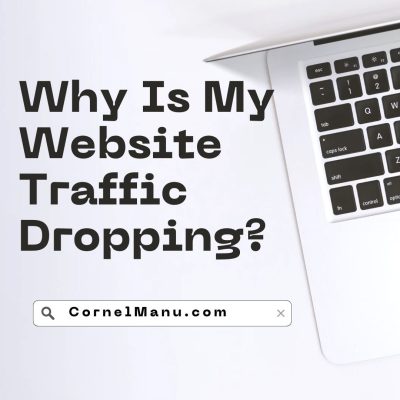Increase your online visibility to boost your sales by up to 30%+ per year. 📈
Get to the top spot in Google without breaking the bank!
Why Is My Website Traffic Dropping?
 Seeing a sudden or steady decline in your website’s traffic can be stressful, especially if your business relies on online visibility and customer acquisition.
Seeing a sudden or steady decline in your website’s traffic can be stressful, especially if your business relies on online visibility and customer acquisition.
Understanding the reasons behind a traffic drop is key to making improvements and restoring growth. In this article, we’ll explore common reasons why website traffic may decline, from algorithm updates to technical and content issues, and even seasonal factors.
1. Algorithm Updates and Penalties
Google and other search engines frequently update their algorithms to improve the relevance and quality of search results. These updates can affect websites significantly, and depending on the nature of the changes, your site might gain or lose traffic.
- Google Algorithm Updates: Core updates and smaller algorithm tweaks often shift website rankings, sometimes dramatically. For example, core updates focus on providing better search results by re-evaluating ranking factors like content quality and user experience. If a site doesn’t align with Google’s new ranking priorities, it could experience a decrease in rankings and traffic. Monitoring SEO trends and understanding the type of content or practices Google values is essential to avoid traffic drops from these updates.
- Manual and Algorithmic Penalties: If Google’s system flags your website for violating its guidelines, you might incur a penalty, resulting in a drop in rankings and traffic. These penalties can be either algorithmic or manual. Algorithmic penalties typically result from black-hat SEO practices like keyword stuffing or spammy backlinks, while manual penalties occur when a human reviewer flags your site for issues. Recovering from these penalties usually involves identifying and correcting the issues, such as removing low-quality backlinks or improving thin content.
Pro tip: Regularly check for updates using Google’s Search Console and SEO industry resources. Google often announces major updates, which can help you understand if your traffic drop coincides with a change in their algorithm.
2. Keyword Ranking Shifts
The keywords that drive traffic to your site are constantly shifting in rank. Several factors can cause your targeted keywords to lose ground, resulting in reduced traffic:
- Keyword Volatility: Keywords that brought in significant traffic previously might fluctuate due to seasonal trends, search volume changes, or shifts in user intent. For instance, if your keywords are highly competitive or in demand, rankings can easily fluctuate if other sites start optimizing for those same keywords.
- Competitor Activity: Competitors are continuously working to improve their rankings, and their success can impact your visibility. If competitors release high-quality content targeting your keywords or improve their SEO overall, they may surpass your site in the rankings. To remain competitive, it’s important to monitor competitors and keep your content fresh, relevant, and comprehensive.
Pro tip: Use keyword tracking tools like SEMrush or Ahrefs to monitor keyword performance and competitor activity. This can help you identify specific keywords that are losing rank and understand if new competitors are affecting your traffic.
3. Content Relevance and Quality Issues
Content is at the core of SEO, and search engines consistently reward sites that deliver valuable, high-quality information. If your website content is outdated or low-quality, it can harm your rankings and result in traffic drops.
- Outdated Content: Over time, content can become irrelevant as industry standards, user preferences, or even general knowledge evolves. For example, technology-related content might become outdated quickly, while seasonal content may not remain relevant year-round. Keeping your content updated with accurate, relevant information can help maintain rankings.
- Content Quality: Low-quality or “thin” content, which doesn’t provide value to readers, may no longer perform well. Google prioritizes informative and comprehensive content, so if your pages are too brief, duplicate other content, or don’t meet users’ needs, rankings and traffic may suffer. Updating or expanding content to ensure it addresses user intent can help improve rankings and boost traffic.
Pro tip: Conduct regular content audits to identify outdated, low-quality, or irrelevant content. Update old articles with fresh insights and add depth where needed to keep your content competitive.
4. Technical SEO Issues
Technical SEO is critical for helping search engines find, crawl, and index your site effectively. Any technical issues that hinder these processes can negatively impact your traffic.
- Crawling and Indexing Errors: Search engines use bots to crawl and index your site, and issues in this process can mean some of your pages aren’t getting indexed. Common issues include broken links, missing XML sitemaps, improper use of robots.txt, or misconfigured canonical tags. When pages are not indexed correctly, they won’t appear in search results, leading to a decrease in organic traffic.
- Site Speed and Mobile Usability: Google considers page speed and mobile-friendliness as ranking factors, so if your site is slow or doesn’t perform well on mobile devices, it could impact your rankings and traffic. Pages that take too long to load increase bounce rates, as users are more likely to leave a site that loads slowly. Additionally, if your site isn’t optimized for mobile users, you may miss out on significant mobile traffic.
Pro tip: Regularly perform technical SEO audits using tools like Google Search Console, Screaming Frog, or GTmetrix. These tools can help you identify technical issues that might be impacting your website’s performance in search results.
5. User Experience (UX) and Engagement Metrics
Google values user experience (UX) and engagement signals when determining rankings. Poor UX can lead to higher bounce rates and lower dwell times, both of which can indicate that users aren’t finding what they need on your site.
- Bounce Rate and Dwell Time: Bounce rate measures how quickly users leave your site after arriving, while dwell time is the amount of time users spend on a page before returning to search results. High bounce rates and low dwell times can indicate that users didn’t find value in the page, which may lead to lower rankings. Improving the relevance and quality of content can keep users engaged, reducing bounce rates and increasing dwell times.
- Changes in User Behavior: User preferences and behaviors evolve, often shifting toward mobile and voice searches. If your site isn’t optimized for these trends, you could miss out on traffic. For example, a mobile-responsive design is essential as Google’s mobile-first indexing prioritizes mobile-friendly sites. Similarly, if you’re targeting voice search queries, you might need to optimize for more conversational phrases.
Pro tip: Improve UX by making navigation intuitive, optimizing for mobile, and including interactive elements like videos or infographics to keep users engaged. Additionally, regularly analyze your bounce rates and user behavior in Google Analytics to identify pages that may need UX improvements.
6. Seasonality and Market Trends
Some traffic drops may be less about SEO and more about natural seasonality or changes in market trends.
- Seasonal Variations: Many industries experience seasonal traffic changes based on holidays, weather, or consumer behavior cycles. For instance, retail websites may see higher traffic during the holiday season and then a dip afterward. Understanding the seasonality of your industry can help you anticipate these fluctuations and avoid unnecessary concern.
- Market Shifts: Sometimes, external factors like economic changes or emerging trends can impact traffic. For example, if there’s a sudden decrease in demand for your products or services, search interest and traffic might decline. Staying updated on industry trends can help you adapt your SEO strategy to align with changes in consumer behavior and search demand.
Pro tip: Use Google Trends to monitor search volume for relevant topics and keywords, and analyze seasonal patterns to better predict traffic fluctuations.
7. Tracking and Analytics Issues
Sometimes, traffic drops may be due to problems with tracking and analytics setup rather than actual decreases in visitors.
- Incorrect Tracking Setup: If you’ve recently made changes to your site, it’s possible that a tracking code was accidentally removed or improperly configured, leading to inaccurate data. Double-check that your Google Analytics or other tracking codes are installed correctly on all pages to ensure accurate traffic reporting.
- Changes in Measurement and Reporting: With the introduction of Google Analytics 4 (GA4) and other updates, some metrics and reporting methods have changed. If your website has transitioned to a new analytics setup, data might look different from previous reports. Understanding these changes can prevent confusion and ensure that you’re interpreting data correctly.
Pro tip: Regularly review your tracking code implementation and ensure all pages are accounted for. If you’ve recently switched to GA4, familiarize yourself with the new reporting features to gain an accurate view of traffic trends.
Conclusion
Traffic drops can happen for various reasons, and diagnosing the cause is the first step toward recovery. By examining factors like algorithm updates, keyword shifts, content quality, technical SEO, user experience, seasonality, and analytics setup, you can identify areas for improvement and begin to rebuild your website’s visibility.
A comprehensive SEO strategy that focuses on high-quality content, technical optimization, and user experience is more effective in the long run than relying on quick fixes. Consistent monitoring and regular SEO audits are essential for catching potential issues before they significantly impact your traffic. Investing in a well-rounded SEO approach can help your website adapt to changes in search algorithms, user behavior, and industry trends, securing stable and sustainable growth over time.
Share this:
- Click to share on X (Opens in new window) X
- Click to share on Facebook (Opens in new window) Facebook
- Click to share on LinkedIn (Opens in new window) LinkedIn
- Click to share on Reddit (Opens in new window) Reddit
- Click to share on Tumblr (Opens in new window) Tumblr
- Click to share on Pinterest (Opens in new window) Pinterest


Leave a Comment